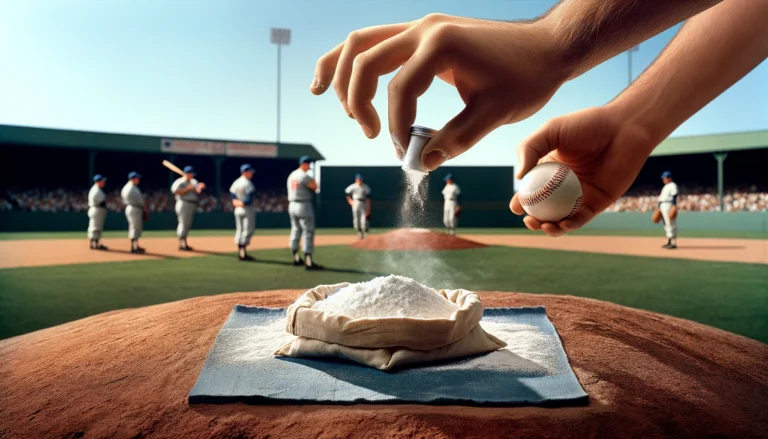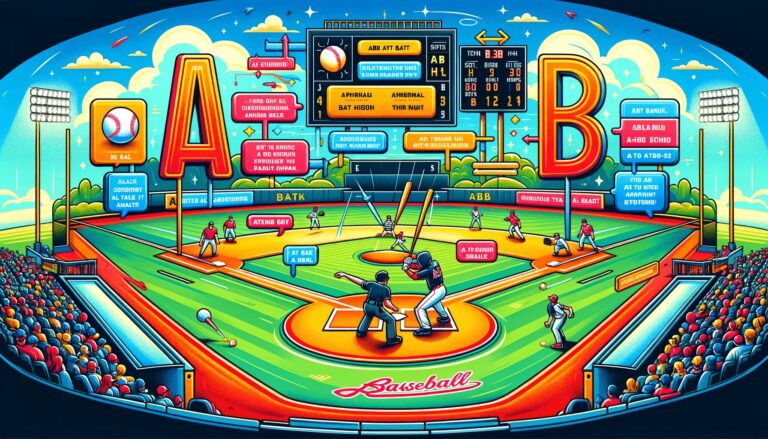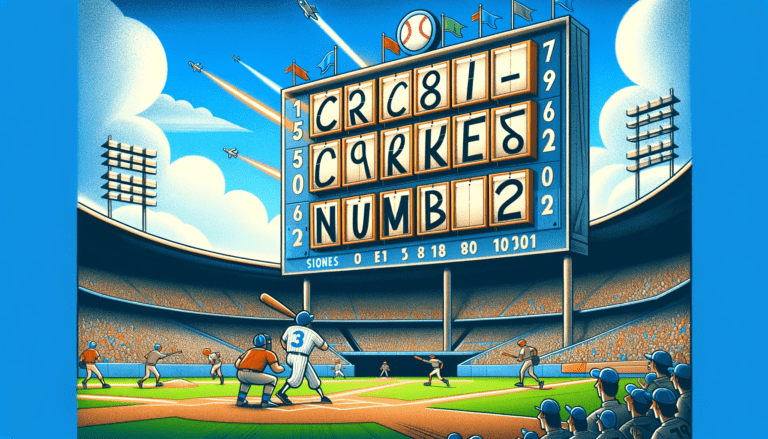What is RBI in Baseball?
RBI stands for Runs Batted In, which is one of the most important statistics in baseball. It measures how many runs a player drives in with their hits, walks, or other actions that allow runners to score.
The more RBIs a player has, the better they are at helping their team score runs and win games. RBIs are earned when a batter gets a hit, walks, or is hit by a pitch with runners on base, allowing those runners to cross home plate.
It’s a key statistic for evaluating a hitter’s offensive performance and their ability to produce runs for their team.
Key Takeaways
- RBIs are a crucial statistic in baseball, serving as a key indicator of a player’s ability to contribute to the team’s offense and influence the outcome of the game.
- The physical aspects of hitting, such as exit velocity, bat speed, and the quality of contact (Barrels/BBE), are significant factors that affect a player’s RBI potential.
- Pitching dynamics, including left/right splits, groundball to flyball ratios, and metrics like WHIP and ERA, play a role in creating RBI opportunities for batters.
- Strategic considerations, like a batter’s position in the lineup and their approach at the plate (e.g., selective aggressiveness in hitters’ counts), are essential for maximizing RBI production.
- Batted ball data and pitch metrics are increasingly used to inform strategies for enhancing RBI output, demonstrating the importance of analytics in modern baseball.
The Anatomy of RBI: Decoding the Impact on the Game
The Significance of Runs Batted In
In the realm of baseball statistics, Runs Batted In (RBI) stands out as a critical measure of a player’s contribution to their team’s offensive success.
An RBI occurs when a batter’s action at the plate directly leads to a run being scored, excluding instances when the run scores due to an error or a ground out that leads to a double play.
The value of RBIs extends beyond mere numbers; it reflects a player’s ability to perform under pressure and with runners in scoring position.
Here are some key aspects of RBIs:
- They indicate a player’s clutch performance.
- RBIs can influence a game’s outcome by driving in crucial runs.
- A high RBI count is often associated with strong situational hitting and a deep understanding of the game.
While RBIs are an individual statistic, they are inherently tied to team dynamics, as they depend on teammates reaching base.
Therefore, a player’s RBI total can also serve as an indicator of the team’s overall offensive efficiency. You may read the guide on What Does GIDP Mean in Baseball
Understanding RBI in Different Game Situations
The ability to drive in runs is a coveted skill in baseball, and it varies widely depending on the game situation.
Key moments often demand a different approach at the plate, whether it’s with runners in scoring position or the bases loaded.
Here are some scenarios where RBI opportunities tend to arise:
- With less than two outs, a player might focus on making contact to bring a runner home from third.
- In late-game situations, a batter may take a more aggressive swing to drive in crucial runs.
- Against different types of pitchers, the strategy to produce RBIs can shift, with batters exploiting specific weaknesses.
Understanding these nuances is essential for players looking to maximize their RBI count. It’s not just about power or contact but also about situational awareness and adaptability.
Players who excel in these high-pressure moments can significantly influence the outcome of a game and are often seen as clutch performers.
Historical RBI Milestones and Records
Throughout the history of baseball, certain RBI milestones and records have stood as testaments to players’ offensive prowess.
Hank Aaron’s career 2,297 RBIs, a record that stood for decades, exemplifies the remarkable consistency and longevity required to reach such heights.
Other notable achievements include:
- Lou Gehrig’s 184 RBIs in a single season, setting a benchmark for future sluggers.
- Hack Wilson’s 191 RBIs in 1930, a record for the National League that still stands today.
- Alex Rodriguez became the youngest player to reach 1,000 RBIs, showcasing early career dominance.
These records not only highlight individual excellence but also serve as milestones that inspire current and future generations of hitters.
The chase for these records adds a layer of excitement to the game, as fans witness potential history in the making with each at-bat of an RBI leader.
Read Also: What Does R Mean in Baseball
The Science Behind the Swing: Factors Influencing RBI

Exit Velocity and Its Correlation with RBI
Exit velocity is a critical metric in understanding a player’s ability to produce RBIs. The higher the exit velocity, the more likely the ball is to result in a hit, and consequently, drive in runs.
Amed Rosario’s recent RBI triple is a testament to this, with an impressive exit velocity of 95.5 mph.
Key factors that influence exit velocity include the batter’s strength, bat speed, and the point of contact on the bat.
Here are some points to consider:
- A well-timed swing that connects with the ball’s sweet spot can significantly increase exit velocity.
- Batters who consistently achieve high exit velocities are often seen as power hitters with a higher RBI potential.
- Exit velocity also helps in assessing the quality of contact, which is directly linked to a batter’s success at the plate.
Understanding and analyzing exit velocity data can provide valuable insights into a player’s performance and RBI capabilities. It’s not just about swinging harder but also about making smarter, more efficient contact. You may read the guide on What Does HBP Mean in Baseball
The Role of Barrels/BBE in Producing RBIs
In the quest to drive in runs, the concept of Barrels per Batted Ball Event (Barrel %) has emerged as a critical metric.
A Barrel is characterized by a batted ball that not only meets a minimum exit velocity of 98 MPH but also possesses the ideal launch angle, leading to a significant chance of becoming a hit.
The potency of Barrels is underscored by their historical correlation with a batting average of at least .500 and a slugging percentage of 1.500.
When analyzing RBI production, it’s essential to consider these factors:
- The higher the Barrel %, the greater the likelihood of a player producing RBIs.
- A player’s ability to consistently generate Barrels indicates a potent combination of power and precision.
- Barrels are often the result of optimal swing mechanics and pitch selection.
Understanding and leveraging Barrels/BBE can be a game-changer for hitters aiming to maximize their RBI count.
By focusing on the quality of contact, players can enhance their chances of delivering when runners are in scoring positions.
How Bat Speed and Aggressiveness Affect RBI Potential
Bat speed is a critical component in a hitter’s ability to drive in runs. A swift bat can translate into higher exit velocities, increasing the likelihood of the ball reaching the outfield gaps or clearing the fences for extra-base hits.
Aggressiveness at the plate, when timed correctly, can also enhance RBI potential. Hitters who are assertive in favorable counts tend to capitalize on pitchers’ mistakes, turning them into run-scoring opportunities.
Key factors that influence RBI potential through bat speed and aggressiveness include:
- The ability to generate quick bat speed leads to harder hit balls.
- Recognizing and exploiting pitchers’ patterns to anticipate fastballs.
- Adjusting swing mechanics to maintain barrel control and maximize contact.
However, there’s a delicate balance to maintain. Over-aggressiveness can lead to chasing bad pitches, while under-aggressiveness might result in missed opportunities.
Successful hitters find the sweet spot, knowing when to unleash their power and when to stay disciplined, ensuring they make the most of their RBI chances.
See Also: What Does E Mean in Baseball
Pitching Dynamics: How They Affect RBI Opportunities

Analyzing Left/Right Pitching Splits and RBI Trends
The strategic matchup between pitcher and batter is a chess game, with left/right splits revealing much about potential RBI outcomes.
Batters often show a preference for facing pitchers with the opposite hand dominance, which can lead to more favorable RBI situations.
For instance, a right-handed batter may have a higher batting average against left-handed pitchers (LHP) and vice versa.
Key statistics such as Batting Average Against (BAA) can illustrate these trends. Since 2022, there has been a noticeable difference in BAA when comparing left and right-handed pitchers:
- BAA vs LHP decreased by 17% in 2024
- BAA vs LHP saw a 100% decrease in 2023
- A 7% decrease in BAA vs LHP was observed in 2022
These figures suggest that left-handed pitchers have become increasingly effective against batters, which could impact the number of RBIs a player might generate.
Understanding these splits is crucial for teams when constructing lineups and for players to adapt their approach at the plate. You may also read What Does SU Mean in Baseball
The Impact of Groundball to Flyball Ratio on RBIs
The groundball to flyball ratio (GB/FB) is a critical metric in understanding a pitcher’s tendency to induce groundballs versus flyballs.
A higher GB/FB ratio suggests a pitcher is more likely to generate groundballs, which can influence RBI opportunities in several ways:
- Groundballs often result in more double plays, reducing the chances for RBIs.
- Conversely, flyballs have a higher potential to turn into sacrifice flies or home runs, leading to more RBIs.
Pitchers with a high GB/FB ratio may limit the number of runs batted in by keeping the ball in the infield. However, this can be a double-edged sword, as groundballs can also sneak through the infield for hits, potentially driving in runs.
Analyzing a pitcher’s GB/FB ratio alongside other metrics like HR/9, ERA, and WHIP can provide a more comprehensive picture of their impact on RBI situations.
Understanding the Relationship Between WHIP, ERA, and RBIs
The relationship between a pitcher’s WHIP (Walks plus Hits per Inning Pitched), ERA (Earned Run Average), and the RBIs (Runs Batted In) they allow is a complex interplay that can reveal much about a pitcher’s effectiveness.
A high WHIP often correlates with a higher ERA, indicating that pitchers who allow more batters to reach base typically concede more earned runs. This, in turn, can lead to an increase in RBIs against them.
Key statistics such as HR/9 (home runs allowed per nine innings) and BB/9 (walks per nine innings) are critical in understanding this relationship.
For instance:
- A pitcher with a high HR/9 is more likely to give up runs via the long ball, impacting their ERA and the number of RBIs they surrender.
- Conversely, a pitcher who maintains a low BB/9 minimizes the number of free passes, potentially reducing the number of RBI situations.
Ultimately, the goal for pitchers is to keep these numbers as low as possible to limit RBI opportunities for the opposition.
Analyzing splits, such as home versus away performances, can also provide insights into a pitcher’s susceptibility to allowing RBIs in different environments.
See Also: What is Lob in Baseball
Strategic Aspects of RBI Production

The Importance of Hitters’ Counts and Selective Aggressiveness
In baseball, the importance of hitters’ counts and selective aggressiveness cannot be overstated.
A hitter’s approach at the plate in these counts often dictates the quality of the pitch they receive and, consequently, the likelihood of producing RBIs.
- Balls Hit 95+ MPH: This metric indicates the power behind a swing, which is often seen in favorable counts.
- Swinging Strike: A low percentage here reflects a hitter’s ability to avoid bad pitches and wait for one they can drive.
Hitters who can effectively ‘green-light’ themselves, swinging with confidence and authority in these counts, tend to punish mistake fastballs and capitalize on RBI opportunities.
Conversely, passivity can lead to falling behind in counts, making it more challenging to generate offensive success.
The balance between aggression and patience is a delicate dance that can define a player’s RBI production.
Position in the Batting Order and Its Influence on RBI
The position in the batting order is a critical factor in a player’s RBI production. Hitters at the top of the order, like Mookie Betts, are more likely to have a higher number of plate appearances, increasing their chances to bat in runs.
Conversely, players batting lower might face fewer RBI opportunities but can capitalize on situations with runners on base.
- Top-order hitters often benefit from more at-bats and the potential to drive in runs early in the game.
- Middle-order hitters are typically power hitters tasked with driving in the top of the order and setting the stage for later innings.
- Lower-order hitters may have fewer at-bats but can provide crucial RBIs in tight games.
Understanding a player’s batting position is essential for predicting RBI performance. Esteury Ruiz, for example, despite leading in stolen bases, fell short of 50 RBI due to his batting position and specific role within the team’s strategy.
Leveraging Batted Ball Data and Pitch Metrics in RBI Strategy
In the quest to maximize RBIs, batted ball data and pitch metrics are invaluable tools for hitters.
By analyzing exit velocity, hitters can gauge the power behind their swings, which is directly linked to their ability to drive in runs.
A higher exit velocity often translates to more distance, increasing the chances of extra-base hits that can clear the bases.
Key metrics such as Barrels/BBE (Batted Ball Events) percentages provide insight into the quality of contact.
When a hitter consistently achieves a high percentage of barrels, they are more likely to produce RBIs due to the optimal combination of exit velocity and launch angle.
Additionally, understanding a pitcher’s groundball to flyball ratio can inform a batter’s approach at the plate, aiming to exploit tendencies that may lead to more RBI opportunities.
To effectively leverage these metrics, players and coaches can:
- Review historical data to identify patterns and pitcher vulnerabilities.
- Utilize advanced stats like spin rate and balls hit at 95+ MPH to refine hitting strategies.
- Adjust swing mechanics based on feedback from exit velocity and launch angle measurements.
Ultimately, the strategic use of batted ball data and pitch metrics can lead to more informed decisions at the plate, enhancing a player’s RBI potential.
Read Also: What Does DFA Mean in Baseball
Conclusion
In conclusion, understanding RBI in baseball is crucial for appreciating a player’s offensive performance. It’s not just about hitting the ball; it’s about driving in runs and helping the team succeed.
Whether you’re a seasoned fan or just starting to learn the game, knowing the significance of RBI adds depth to your baseball knowledge.
So, next time you watch a game, keep an eye on those RBI stats—they tell a story of teamwork, strategy, and skill on the diamond.
Frequently Asked Questions
What is the significance of Runs Batted In (RBI) in baseball?
RBIs are a critical statistic in baseball that measure a player’s ability to drive in runs, contributing directly to the team’s scoring and often indicating a player’s clutch performance in key situations.
How does exit velocity correlate with RBI production?
Higher exit velocity generally leads to harder-hit balls, which can translate into more hits and a greater chance of driving in runs, thus increasing a player’s RBI count.
What is the role of barrels/BBE in producing RBIs?
Barrels, or batted ball events with optimal exit velocity and launch angle, have a higher chance of becoming hits, particularly extra-base hits, which can significantly boost RBI totals.
In what way does a hitter’s count influence RBI production?
Hitters’ counts, such as 2-0 or 3-1, often lead to more predictable pitches, like fastballs, allowing batters to swing more aggressively and increase their chances of driving in runs.
Why is a player’s position in the batting order important for RBI potential?
A player’s batting order position influences RBI opportunities, with middle-order hitters typically getting more chances with runners on base compared to those leading off or at the bottom of the order.







